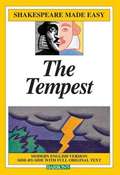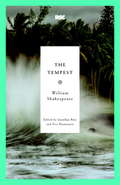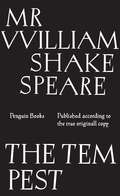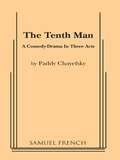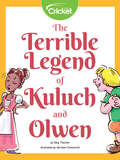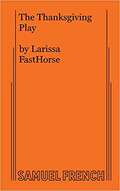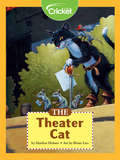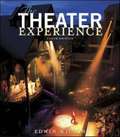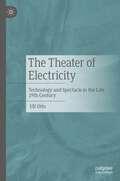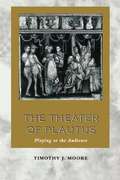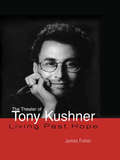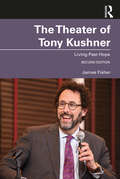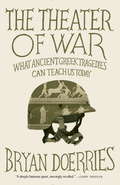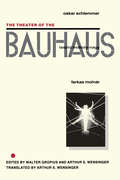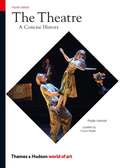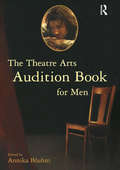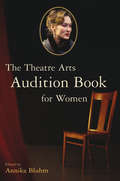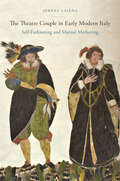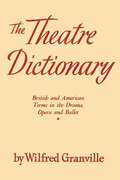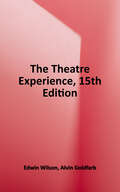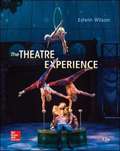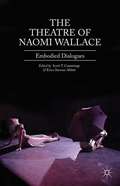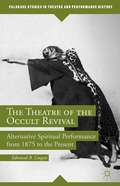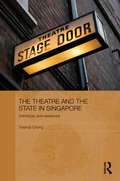- Table View
- List View
The Tempest: Modern English Version Side-by-Side With Full Original Text (Shakespeare Made Easy Series)
by William Shakespeare Alan DurbandThis wonderful presentation of Shakespeare's The Tempest features the play's original lines on each left-hand page, and a modern, easy-to-understand "translation" on the facing right-hand page. This invaluable teaching-study guide also includes: Helpful background information that puts the play in its historical perspective Discussion questions that teachers can use to spark student class participation, and which students can use as springboards for their own themes and term papers Fact quizzes, sample examinations, and other features that improve student comprehension of what the play is about
The Tempest: Or, The Enchanted Island
by William Shakespeare Jonathan Bate Eric RasmussenThis joyous play, the last comedy of Shakespeare's career, sums up his stagecraft with a display of seemingly effortless skill. Prospero, exiled Duke of Milan, living on an enchanted island, has the opportunity to punish and forgive his enemies when he raises a tempest that drives them ashore--as well as to forestall a rebellion, to arrange the meeting of his daughter, Miranda, with an eminently suitable young prince, and, more important, to relinquish his magic powers in recognition of his advancing age. Richly filled with music and magic, romance and comedy, the play's theme of love and reconciliation offers a splendid feast for the senses and the heart.From the Paperback edition.
The Tempest: Published According to the True Originall Copy
by William ShakespeareShakespeare's Plays: The First Folio is a beautiful new Penguin edition of William Shakespeare's first folio, with original spelling, getting as close as possible to the original plays for an authentic reading experience. It is published to coincide with the RSC's World Shakespeare Festival, and the 2012 Cultural Olympiad. William Shakespeare was the finest poet and playwright in the English language, whose dramas such as Hamlet, Macbeth, King Lear and Romeo and Juliet are read and watched by millions globally. We are used to reading his work effectively in translation, with modernised spelling, footnotes and glosses. This new Penguin edition allows us to experience the original as it was intended, in a beautiful hardback volume.
The Tenth Man: A comedy-Drama in Three Acts
by Paddy ChayefskyIn an old meeting room now used as a temple, a rabbi and various Jews meet for prayer on a winter day. They are not all devout; one is a comic atheist who says he only comes to the temple to keep warm and another is a young agnostic lawyer who has made a mess of his life and whom analysis is keeping from brink of suicide. One of the ten men who come this day brings his granddaughter who is in a trance. He believes she is possessed by a dybbuk; some of the others think she is just plain crazy. She glides from periods of lucidity into absolute irrationality and then into trance. During saner moments, she and the young agnostic are attracted to one another. The rabbi, convinced she has a dybbuk, arranges an exorcism. At the culmination of the ritual, it is the dybbuk of the young man that is exorcised, the one that has prevented him from loving anyone.
The Terrible Legend of Kuluch and Olwen
by Meg ThacherPrince Kuluch has been cursed by his evil stepmother! Now he is in love with the daughter of a giant. Follow Kuluch as he completes the list of tasks from the giant with the help of knights, King Arthur, and even ants! Will he be able to marry the love of his life?
The Thanksgiving Play
by Larissa FasthorseGood intentions collide with absurd assumptions in Larissa FastHorse’s wickedly funny satire, as a troupe of terminally “woke” teaching artists scrambles to create a pageant that somehow manages to celebrate both Turkey Day and Native American Heritage Month.
The Theater Cat
by Marilyn HelmerFor generations, the LeChats had kept the mouse problem in the Old Lighthouse Theater under control. But Purrcey LeChat doesn't want to hunt mice—he wants to see his name up in lights!
The Theater Experience (10th Edition)
by Edwin WilsonThe ideal theater appreciation text for courses focusing on theater elements, The Theater Experience encourages students to be active theater-goers as they learn about the fundamentals of a production. By addressing the importance of the audience, Wilson brings the art of performance to life for students who may have little experience with the medium.
The Theater of Electricity: Technology and Spectacle in the Late 19th Century
by Ulf OttoSince the 1880s, electrical energies started circulating in European theaters, generated from fossil fuels in urban power plants. A mysterious force, which was still traded as romantic life force by some and for others had already come to stand in for progress, entered performance venues. Engineering knowledge, control techniques and supply chains changed fundamentally how theater was made and thought of. The mechanical image machine from Renaissance and Baroque times was transformed into a thermodynamic engine. Modern theater turned out to be electrified theater. – Retracing what happened backstage before the Avantgarde took to the front stage, this book proposes to write the genealogy of theaters modernity as a cultural history of theater technology.
The Theater of Plautus: Playing to the Audience
by Timothy J. MooreThe relationship between actors and spectators has been of perennial interest to playwrights. The Roman playwright Plautus (ca. 200 BCE) was particularly adept at manipulating this relationship. Plautus allowed his actors to acknowledge freely the illusion in which they were taking part, to elicit laughter through humorous asides and monologues, and simultaneously to flatter and tease the spectators.<P><P>These metatheatrical techniques are the focus of Timothy J. Moore's innovative study of the comedies of Plautus. The first part of the book examines Plautus' techniques in detail, while the second part explores how he used them in the plays Pseudolus, Amphitruo, Curculio, Truculentus, Casina, and Captivi. Moore shows that Plautus employed these dramatic devices not only to entertain his audience but also to satirize aspects of Roman society, such as shady business practices and extravagant spending on prostitutes, and to challenge his spectators' preconceptions about such issues as marriage and slavery. These findings forge new links between Roman comedy and the social and historical context of its performance.
The Theater of Tony Kushner (Studies in Modern Drama)
by James FisherThe Theater of Tony Kushner is a comprehensive portrait of the life and work of one of America's most important contemporary playwrights.
The Theater of Tony Kushner: Living Past Hope
by James FisherThe Theater of Tony Kushner is a comprehensive portrait of the forty-year long career of dramatist Tony Kushner as playwright, screenwriter, essayist, and public intellectual and political activist.Following an introduction examining the influences of Kushner’s development as an artist, this updated second edition features individual chapters on his major plays, including A Bright Room Called Day, Hydriotaphia, or The Death of Dr. Browne, Angels in America, Slavs! Thinking About the Longstanding Problems of Virtue and Happiness, Homebody/Kabul, Caroline, or Change, and The Intelligent Homosexual’s Guide to Capitalism and Socialism with a Key to the Scriptures, along with chapters on Kushner’s adaptations, one-act plays, and screenplays, including his two Academy Award-nominated screenplays, Munich and Lincoln.A book for anyone interested in theater, film, literature, and the ways in which the past informs the present, this second edition of The Theater of Tony Kushner explores how his writings reflect key elements of American society, from politics and economics to race, gender, and spirituality, all with the hope of inspiring America to live up to its ideals.
The Theater of War: What Ancient Greek Tragedies Can Teach Us Today
by Bryan DoerriesThis is the personal and deeply passionate story of a life devoted to reclaiming the timeless power of an ancient artistic tradition to comfort the afflicted. For years, theater director Bryan Doerries has led an innovative public health project that produces ancient tragedies for current and returned soldiers, addicts, tornado and hurricane survivors, and a wide range of other at-risk people in society. Drawing on these extraordinary firsthand experiences, Doerries clearly and powerfully illustrates the redemptive and therapeutic potential of this classical, timeless art: how, for example, Ajax can help soldiers and their loved ones better understand and grapple with PTSD, or how Prometheus Bound provides new insights into the modern penal system. These plays are revivified not just in how Doerries applies them to communal problems of today, but in the way he translates them himself from the ancient Greek, deftly and expertly rendering enduring truths in contemporary and striking English. The originality and generosity of Doerries's work is startling, and The Theater of War--wholly unsentimental, but intensely felt and emotionally engaging--is a humane, knowledgeable, and accessible book that will both inspire and enlighten. Tracing a path that links the personal to the artistic to the social and back again, Doerries shows us how suffering and healing are part of a timeless process in which dialogue and empathy are inextricably linked.From the Hardcover edition.
The Theater of the Bauhaus
by Oskar Schlemmer Arthur S. Wensinger Walter Gropius Lazlo Moholy-Nagy Farkas MolnarFew creative movements have been more influential than the Bauhaus, under the leadership of Walter Gropius. The art of the theater commanded special attention. The text in this volume is a loose collection of essays by Oskar Schlemmer, Laszlo Moholy-Nagy, and Farkas Molnár (who in an illustrated essay shares his vision of a total theatre space), with an introduction by Bauhaus leader Walter Gropius. Originally published in German in 1924, Die Bühne im Bauhaus was translated by A. S. Wensinger and published by Wesleyan in 1961. It was prepared with the full cooperation of Walter Gropius and his introduction was written specially for this edition.From Bauhaus experiments there emerged a new aesthetic of stage design and presentation, a new concept of "total theater." Its principles and practices, revolutionary in their time and far in advance of all but the most experimental stagecraft today, were largely the work of Oskar Schlemmer, Laszlo Moholy-Nagy, and their students. Profusely illustrated and startling in its typography (the work of Moholy-Nagy), the 1924 volume quickly became a collector's item and is now virtually unobtainable. Those interested in the stage, the modern visual arts, or in the bold steps of the men of genius who broadened the horizons of aesthetic experience will appreciate that this translation is available again.
The Theatre A Concise History 4th edition
by Enoch Brater Phyllis HartnollActing, direction, stagecraft, theatre architecture and design, the extraordinary evolution of dramatic literature—here is an all-embracing and richly illustrated history, worldwide in scope and ranging from the ancient origins of the theatre in the choral hymns sung around the altar of Dionysus to the endless variety of forms that theatre takes in our own day. For this fourth edition, Enoch Brater, Professor of English and Theatre at the University of Michigan, has contributed a revised and extended final chapter on contemporary theatre and updated factual information throughout the book
The Theatre Arts Audition Book for Men
by Annika BluhmFirst Published in 2003. Routledge is an imprint of Taylor & Francis, an informa company.
The Theatre Arts Audition Book for Women
by Annika BluhmFirst Published in 2003. Routledge is an imprint of Taylor & Francis, an informa company.
The Theatre Couple in Early Modern Italy: Self-Fashioning and Mutual Marketing (Performing Celebrity)
by Serena LaienaWho were the first celebrity couples? How was their success forged? Which forces influenced their self-fashioning and marketing strategies? These questions are at the core of this study, which looks at the birth of a phenomenon, that of the couple in show business, with a focus on the promotional strategies devised by two professional performers: Giovan Battista Andreini (1576–1654) and Virginia Ramponi (1583–ca.1631). This book examines their artistic path – a deliberately crafted and mutually beneficial joint career – and links it to the historical, social, and cultural context of post-Tridentine Italy. Rooted in a broad research field, encompassing theatre history, Italian studies, celebrity studies, gender studies, and performance studies, The Theatre Couple in Early Modern Italy revises the conventional view of the Italian diva, investigates the deployment of Catholic devotion as a marketing tool, and argues for the importance of the couple system in the history of Commedia dell’Arte, a system that continues to shape celebrity today.
The Theatre Dictionary: British and American Terms in Drama, Opera, and Ballet
by Wilfred GranvilleWilfred Granville’s Theatre Dictionary is an essential guide to the terms in British and American Drama, Opera, and Ballet, and this volume is of incomparable value for the student and practical theatre worker on either side of the Atlantic. It offers a fascinating compilation of technical jargon and colloquial slang pertaining to the business of the theatre, from the legitimate stage to vaudeville and road shows. For several years Wilfred Granville was actively engaged in the theatre as actor, stage director, and producer and speaks from firsthand knowledge of his subject. A specialist in glossaries, Wilfred Granville has treated theatre speech in a readable, unacademic way though there is no inadequacy in his treatment of etymologies of words and phrases recorded. Wilfred Granville was a British lexicographer known for his jargon and slang dictionaries and his military histories. He researched and wrote dictionaries on sea and naval slang and theatre terms as well as naval military histories.
The Theatre Experience
by Edwin Wilson Alvin GoldfarbThe Theatre Experience, 15e prepares students to be well-informed, well-prepared theatre audience members. With an audience-centered narrative that engages today’s students, a vivid photo program that brings concepts to life, and features that teach and encourage a variety of skill sets, students master core concepts and learn to think critically about theatre and the world around them. As a result, students are better prepared for class and better prepared for theatregoing. The textbook is noted for its lively writing style and for helping students recognize how theatre relates to our everyday lives.
The Theatre Experience Thirteenth Edition
by Edwin WilsonThe thirteenth edition of The Theatre Experience is students' ticket to the best seat in the house. From Broadway to makeshift theater spaces around the world, the author demonstrates the active and lively role they play as audience members by engaging them in the collaborative and creative processes behind and in front of the curtain. Wilson introduces students to the roles of the performers, directors, producers and designers, while emphasizing the insights they as audience members bring to any production. The thirteenth edition better accommodates today's teaching schedules, as well as improves accessibility for students by concise insight and up-to-date vibrant production visuals. Students join the creative process with The Theatre Experience, and rehearse for their role as life-long audience members.
The Theatre Experience, Thirteenth Edition
by Edwin WilsonThe Theatre Experience prepares students to be well-informed, well-prepared theatre audience members. With an audience-centered narrative that engages today's students, a vivid photo program that brings concepts to life, and features that teach and encourage a variety of skill sets students master core concepts and learn to think critically about theatre and the world around them.
The Theatre Of Naomi Wallace
by Scott T. Cummings Erica Stevens AbbittNaomi Wallace, an American playwright based in Britain, is one of the more original and provocative voices in contemporary theatre. Her poetic, erotically-charged, and politically engaged plays have been seen in London's West End, off-Broadway, at the Com#65533;die-Fran#65533;aise, in regional and provincial theaters, and on college campuses around the world. Known for their intimate, sensual encounters examining the relationship between identity and power, Wallace's works have attracted a wide range of theatre practitioners, including such important directors as Dominic Dromgoole, Ron Daniels, Jo Bonney, and Kwame Kwei-Armah. Drawing on scholars, activists, historians, and theatre artists in the United States, Canada, Britain, and the Middle East, this anthology of essays presents a comprehensive overview of Wallace's body of work that will be of use to theatre practitioners, students, scholars, and educators alike.
The Theatre Of The Occult Revival
by Edmund B. LinganBased on field research and archival study, this book offers an in-depth exploration of the religious foundations, political and social significance, and aesthetic aspects of the theatre created by several of the most influential leaders of the Occult Revival: Katherine Tingley, Rudolf Steiner, Marie Steiner-von Sivers, Aleister Crowley, Alexander Mathews, and Gerald Gardner. The Occult Revival was an international surge of interest in the supernatural, magic, and Eastern mysticism that thrived in Europe and the United States between the late nineteenth-century and the mid-twentieth-century. By studying the theatre that was developed in affiliation with occult movements, this book shows how theatre contributed to the complication and fragmentation of Western religious culture during the turn-of-the-century Occult Revival and how theatre continues to play a part in the development of occult rituals and beliefs.
The Theatre and the State in Singapore: Orthodoxy and Resistance (Routledge Contemporary Southeast Asia Series)
by Terence ChongThis book provides a comprehensive examination of the contemporary English-language theatre field in Singapore. It describes Singapore theatre as a politically dynamic field that is often a site for struggle and resistance against state orthodoxy, and how the cultural policies of the ruling People’s Action Party (PAP) have shaped Singapore theatre. The book traces such cultural policies and their impact from the early 1960s, and shows how the PAP used theatre – and arts and culture more widely – as a key part of its nation building programme. Terence Chong argues that this diverse theatre community not only comes into regular conflict with the state, but often collaborates with it - depending on the rewards at stake, not to mention the assortment of intra-communal conflicts as different practitioners and groups vie for the same resources. It goes on to explore how new forms of theatre, especially English-language avant garde theatre, represented resistance to such government cultural control; how the government often exerts its power ‘behind-the-scenes’ to preserve its moral legitimacy; and conversely how middle class theatre practitioners’ resistance to state power is strongly influenced by class and cultural capital. Based on extensive original research including interviews with theatre directors and other theatre professionals, the book provides a wealth of information on theatre in Singapore overall, and not just on theatre-state relations.
